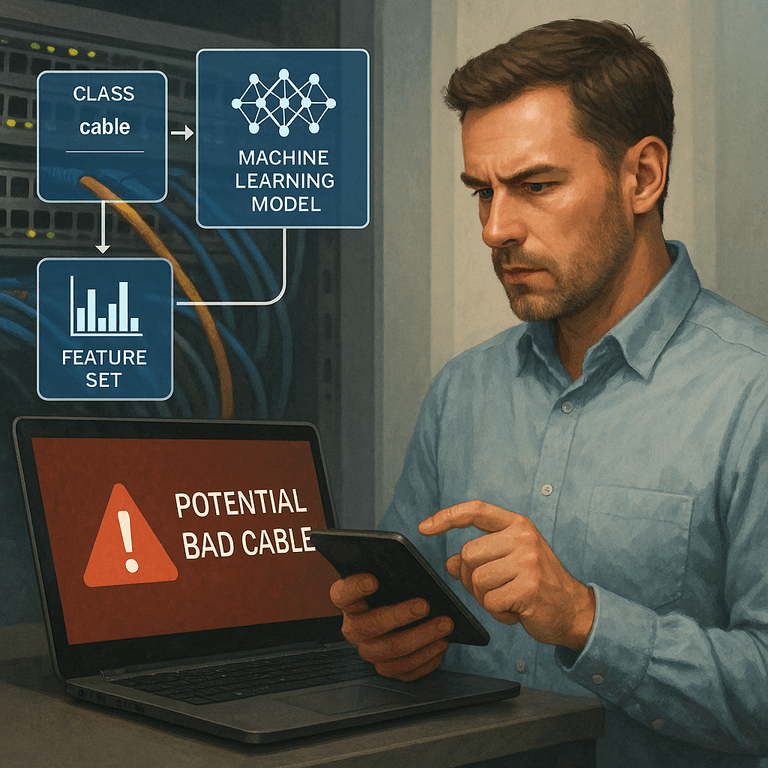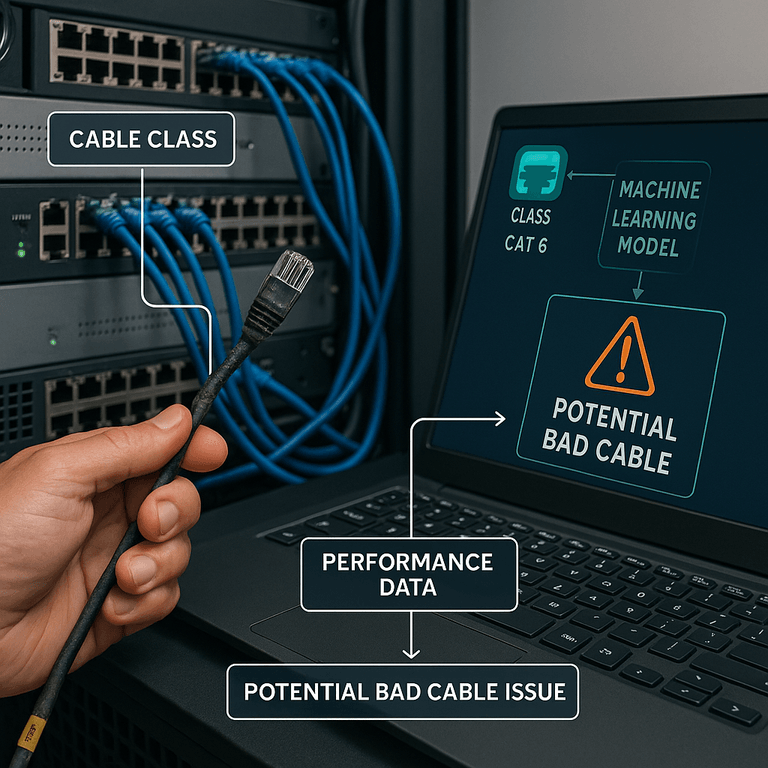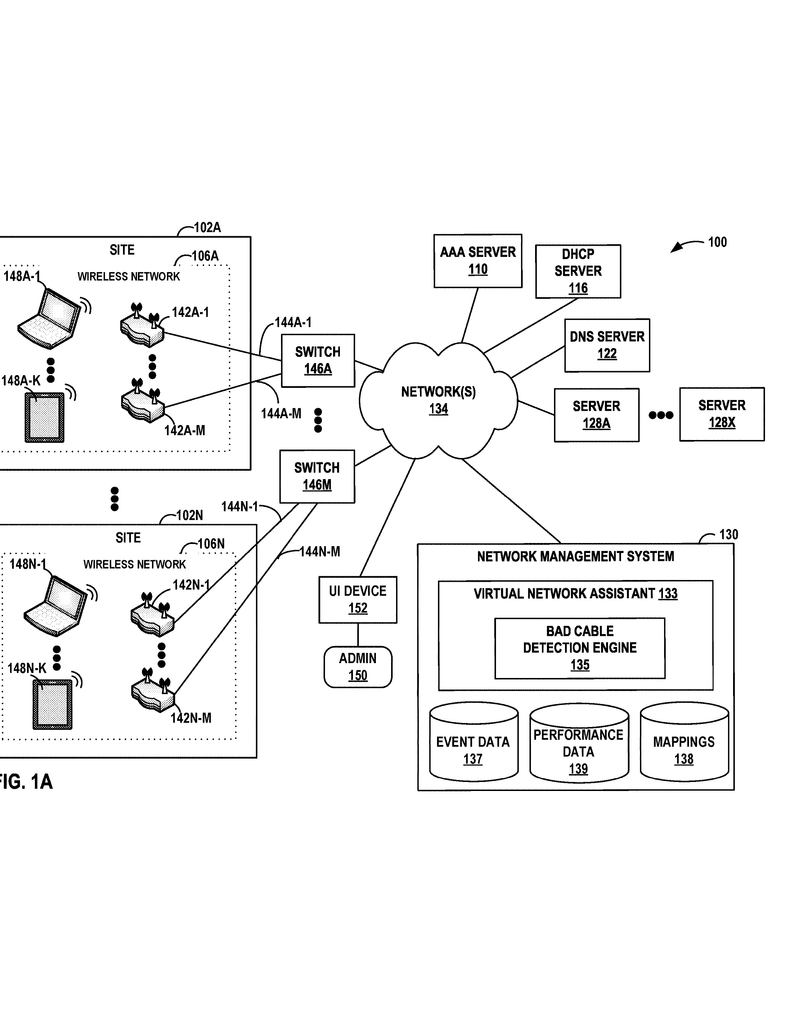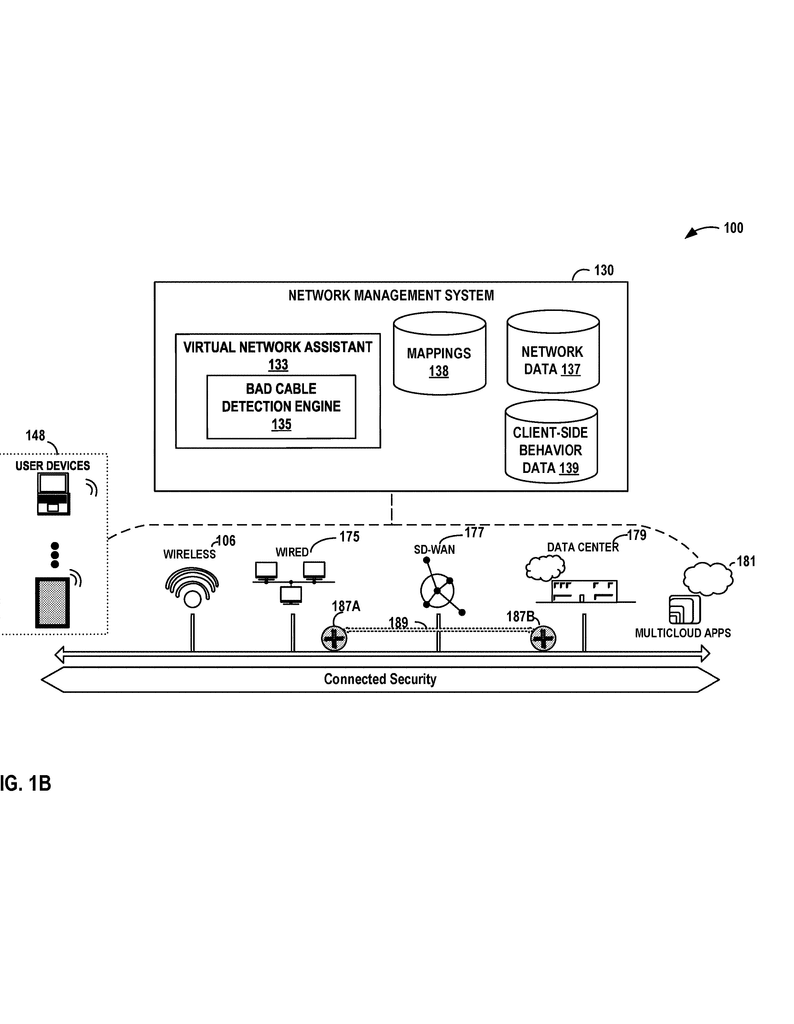Invented by Venkata; Vamsidhar Reddy Devireddy, Ayanile; Pooja Sambhaji, Mishra; Sanjeev Kumar, Mukhopadhyay; Sabyasachi
Networks are everywhere: in schools, hospitals, offices, stores, and even homes. Keeping these networks running smoothly is very important, but sometimes, a simple cable can cause big problems. What if the network could tell you about a bad cable before things go wrong? This is exactly what a new patent application proposes. Let’s unpack how this new system works, why it matters, and how it stands out from what’s already out there.
Background and Market Context
In today’s world, everyone relies on computer networks for work, entertainment, and daily life. These networks connect many devices — computers, phones, tablets, printers, sensors, and lots more. All these devices talk to each other through switches, routers, and cables. Most people focus on the fancy wireless parts, like Wi-Fi, but the real backbone of every network is wires and cables, both copper and fiber optic.
If a cable breaks or gets unplugged, it’s easy to spot: things stop working. However, most cable problems are not so simple. Sometimes, a cable is not plugged in all the way, or it starts to wear out inside. When that happens, some data gets through, but some is lost. This causes slow connections, dropped calls, streaming hiccups, or even outages. These sneaky problems are tough for IT staff to find. They may not know if the trouble is the cable, the device, or something else. Replacing cables randomly wastes time and money, especially in big networks where thousands of cables are used.
The market for network management is huge and growing fast. Businesses want to keep their networks up and running with less manual work. They want systems that can spot issues before they become big problems. That’s where smart, automatic monitoring comes in. Today, many companies use network management systems that collect performance data, send alerts, and help IT staff fix problems. But when it comes to cable issues, most solutions are still very basic. They may notice when a cable is completely dead, but subtle problems often slip through the cracks.
This is especially important for large places like airports, stadiums, or hospitals, where network devices and cables are moved or handled often. Every time someone bumps a cable or moves a device, there is a chance something goes wrong. If a network goes down, it isn’t just an inconvenience. In hospitals, it can impact care. In stores, it can stop sales. In offices, it can halt work. That’s why there’s a strong need for better, smarter ways to watch over cables — ways that can spot trouble early, with less guesswork and less downtime.
The new system described in the patent application addresses this need. It uses machine learning to keep an eye on all cables, watching for signs of trouble, and giving clear, actionable alerts before things get really bad. This can save time, money, and headaches for everyone who depends on networks.
Scientific Rationale and Prior Art
Let’s look at why detecting bad cables is so hard, and what’s been tried before. In the past, network managers relied on a very simple method: run a cable test. This means sending a bunch of data through the cable and seeing if anything gets lost. If packets go missing, the cable is bad. The problem? This test stops all normal traffic for a minute or more. That’s not practical when you have hundreds or thousands of cables, or when you can’t control both ends of a cable (for example, between a customer’s device and a service provider’s network).
Some newer systems use basic monitoring. They track if the link is up or down, count errors, or measure speed. But these systems can only spot the most obvious failures. Subtle issues, like a cable that is starting to fail, may not show up until things get much worse. Plus, cables come in many types: copper, fiber, high-speed, low-speed, from different makers, with different features. A test that works for one cable type may not work for another.
One previous idea, as described in U.S. patent application Ser. No. 17/547,881, used a machine learning model to detect issues with Ethernet cables. While this was a step forward, it only worked for certain types of cables, and could make mistakes if used with other types. For example, a model trained on copper cables might see normal behavior in fiber cables as a problem, and vice versa. This leads to false positives (crying wolf when nothing is wrong) or false negatives (missing real problems).
Because of all these challenges, many IT teams still rely on manual checks, or just wait until users complain. This is slow, expensive, and can damage trust in the network. What’s needed is a way to watch all cables, all the time, no matter the type, and catch problems early.
The scientific rationale behind the new system is simple but powerful. It starts with the idea that every network interface — every port where a cable plugs in — produces lots of performance data. This data includes counts of packets sent and received, errors, signal strengths, and more. Small changes in these numbers can be early signs of a cable going bad.
But here’s the trick: different cables have different “normal” values for these features. A copper cable may have more errors than a fiber cable, even if both are healthy. That’s why the new system uses machine learning models that are trained for each class of cable. By looking at the right features, and comparing them to what’s normal for that cable type, the system can spot problems much earlier and more accurately.
The machine learning models used can be decision trees, random forests, or other similar models. These are good choices because they work well with small amounts of data, can handle different types of features, and are easy to explain. For each cable type, a separate model is trained using real-world data — either from actual cables or from test setups that simulate problems. This way, the system learns what “bad” looks like for each kind of cable.
Once trained, the models can run quickly and often, checking every cable, every few minutes if needed. If a problem is found, the system can alert IT staff, suggest tests, or even take action automatically, like rerouting traffic or running diagnostics. This is a big leap beyond what was possible before.
Invention Description and Key Innovations
Now, let’s dig into what the patent application actually covers and why it’s different. The invention is a network management system that uses a smart set of machine learning models to monitor and diagnose cable problems across all kinds of networks and cable types.
Here’s how it works, step by step:
First, the system keeps a library of machine learning models, each one trained for a specific class of cable. For example, there might be one model for 100G copper cables, one for long-range fiber cables, and so on. When a new cable is plugged in, the system figures out what kind it is, using information from the network device or from a lookup table.
Next, the system collects performance data for each cable. This data can include things like how many packets are sent and received, how many errors happen, how strong the signal is, and more. Not every feature is useful for every cable type, so the system knows which features to use for each model.
Before making a decision, the system can also normalize the data. This means it compares the numbers from one cable to the typical values seen in other cables of the same type. This helps make sure that the model isn’t fooled by differences between brands or models of cables.
With the right data in hand, the system picks the correct machine learning model and runs it on the data. If the model thinks there’s a potential bad cable issue, the system can act fast. It might:
– Alert IT staff with a clear warning and a suggested action (like “run a test” or “replace the cable”)
– Run a deeper diagnostic test automatically, if possible
– Reroute traffic away from the bad cable so users don’t feel the impact
– Keep watching the cable and only alert if the problem sticks around for a while (to avoid false alarms)
One of the big advantages here is flexibility. The system can handle new types of cables as they come out, just by adding a new model. It can spot problems even if the network is made up of many different kinds of cables and devices from different makers.
Another key innovation is that the system can work even if it only controls one side of the cable — perfect for cases where different companies own the two ends. Since it relies on behavior seen from the network side, there’s no need to stop all traffic for special tests.
The patent application also covers how the models are trained. For copper cables, real-world data is used, including both good and bad cables. For optical cables, where failures are rare or hard to simulate, the system can use test equipment to create bad conditions and collect data that way.
The models themselves can be decision trees, random forests, CatBoost, or similar machine learning classifiers. These are tested and tuned to get the best results, with accuracy scores above 95% in tests. The system is designed to update itself as new data comes in, keeping the models sharp and current.
The invention isn’t just a theoretical idea. The patent describes in detail how the system fits into a real network management setup, including cloud-based platforms that can manage thousands of devices and cables, gather data from everywhere, and provide a simple dashboard for IT staff.
A real-world example could look like this: A company has thousands of access points and switches spread across many buildings. Each device sends performance data to the central system every few minutes. The system checks each cable using the right model. If it spots a cable that’s starting to fail, it warns the IT team with the exact port and suggested fix. If the problem gets worse, it can stop using that cable until it’s fixed, keeping the rest of the network running smoothly.
This level of automatic, proactive cable monitoring is a big advance over the old ways. It saves time, prevents downtime, and means IT teams can focus on real problems, not guessing which cable to check next.
Conclusion
Keeping networks healthy is more important than ever. Bad cables are a common but sneaky cause of network trouble, and old ways of finding them are slow and unreliable. This new system brings a smart, machine learning approach that can watch every cable, of any type, all the time. By using the right data and the right model for each cable, it spots trouble early and gives clear, actionable alerts. This saves time, money, and keeps networks running smoothly. As networks get bigger and more complex, tools like this will be key to making sure everything just works.
Click here https://ppubs.uspto.gov/pubwebapp/ and search 20250217245.




